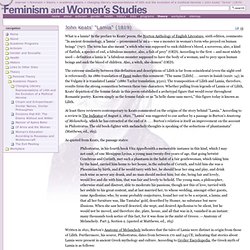

Il punto al qual si traggon d'ogni parte i pesi. Pazuzu_amulet. @pattergab shared a photo from Flipboard. Dore-Destruction-of-Leviathan.png (PNG Image, 482 × 600 pixels) Lilith The Demoness. From Wikipedia Website Lilith (1892), by John Collier.

Lilith (Hebrew: לילית Lilit; Arabic: ليليث Līlīt) is a female Mesopotamian storm demon associated with wind and was thought to be a bearer of disease, illness, and death. The figure of Lilith first appeared in a class of wind and storm demons or spirits as Lilitu, in Sumer, circa 4000 BC. Many scholars place the origin of the phonetic name "Lilith" at somewhere around 700 BC despite post-dating even to the time of Moses.[1] Lilith appears as a night demon in Jewish lore and as a screech owl in Isaiah 34:14 in the King James version of the Bible.
Mesopotamian mythology Etymology Hebrew: לילית; Arabic: ليليث; Akkadian: Līlītu, are female or male nisba adjectives from the proto-Semitic root L-Y-L meaning "Night," literally translating to nocturnal "female night being/demon", although cuneiform inscriptions where Lilit and Lilitu refers to disease-bearing wind spirits exist.[2][3] Some incantations describe her as "seven witches "R. "R. John Keats' "Lamia" (1819) What is a lamia?

In the preface to Keats' poem, the Norton Anthology of English Literature, sixth edition, comments: "In ancient demonology, a 'lamia' -- pronounced la' mi a -- was a monster in woman's form who preyed on human beings" (797). The term has also meant "a witch who was supposed to suck children's blood, a sorceress, also, a kind of flatfish, a species of owl, a fabulous monster, also, a fish of prey" (OED).
According to the first -- and most widely used -- definition a lamia is "a fabulous monster supposed to have the body of a woman, and to prey upon human beings and suck the blood of children. Also, a witch, she-demon" (OED). The extreme similarity between this definition and descriptions of Lilith is far from coincidental (even the night-owl is referenced). At least three reviewers contemporary to Keats commented on the origins of the story behind "Lamia. " SACHERO07 : @ARTEMIZIANA a Bible I might... @pattergab shared a photo from Flipboard. Human_timeline.jpg (JPEG Image, 15941 × 261 pixels) - Scaled (6%) Lilith - Mesopotamian Goddess of Fertility. Lilith is an ancient Middle Eastern/Mesopotamian goddess of abundance, fertility, and fecundity, the giver of agriculture to humanity.

Lilith is associated with the owl, a figure of darkness and deep wisdom, for she is also a goddess of death and transformation. The lotus is also associated with her, a symbolism that tells us much about her. The lotus, is an exquisite flower that grows out of dark, rank, decaying earth - it represents spiritual enlightenment, compassion and wisdom. According to ancient non-biblical Jewish literature and Kabbalistic traditions, Lilith was the first woman God created and the first wife of Adam, made from the earth at either the same time as Adam or before Adam.
This made Lilith equal to Adam, sharing the same responsibilities in the garden of Eden. It was Lilith in serpent form who seduced Eve to eat the fruit of knowledge. Lilith-3. Broca00. Lilith. Lilith as the Serpent by Margi B. 2004-2005 from LilithGate Website Lilith’s link to the garden of Eden is symbolized in Christian iconography that may have been inspired by the Zohar.

Also, Lilith as Serpent is not limited by her functions in Eden, but also as other important figures such as Blind Dragon and Leviathan. There are many passages that define Lilith as Serpent. The most obvious passage, says Lilith as the Serpent had an affair with Eve before she had intercourse with Adam. Quoting Bacharach, ’Emeq haMelekh 23c-d - "And the Serpent, the Woman of Harlotry, incited and seduced Eve through the husks of Light which in itself is holiness. DECEPTION (Lilith- Part 55) DECEPTION (Lilith- Part 55) Sumeranu15_05. @pattergab shared a photo from Flipboard. @pattergab shared a photo from Flipboard. @pattergab shared a photo from Flipboard. User:Lilitu. Lilith. Lilith (Hebrew: לילית; lilit, or lilith) is a Hebrew name for a figure in Jewish mythology, developed earliest in the Babylonian Talmud, who is generally thought to be in part derived from a class of female demons Līlīṯu in Mesopotamian texts of Assyria and Babylonia.

Evidence in later Jewish materials is plentiful, but little information has been found relating to the original Akkadian and Babylonian view of these demons. The relevance of two sources previously used to connect the Jewish Lilith to an Akkadian Lilitu—the Gilgamesh appendix and the Arslan Tash amulets—are now both disputed by recent scholarship.[1] The two problematic sources are discussed below.[2] The Hebrew term Lilith or "Lilit" (translated as "Night creatures", "night monster", "night hag", or "screech owl") first occurs in Isaiah 34:14, either singular or plural according to variations in the earliest manuscripts, though in a list of animals.
Etymology[edit] In Akkadian the terms lili and līlītu mean spirits. [edit] All mythologies. LILITH. Hebrew Lilith Lilith is best known to us as a Hebrew goddess.

According to the Hebrew Apocrypha, Lilith was Adam's first wife, obviously implying that whoever wrote Genesis in the First (Old) Testament, left something out. Adam divorced Lilith, however, after she refused to obey him; some say she refused to assume the missionary position during sex and lie beneath Adam If this myth has any validity, no wonder the Genesis authors thought it wise to leave it out. So much of Genesis has been interpreted as God's irrevocable rules concerning marriage, which imply that there can be no divorce after two persons have become one flesh. The Lilith Myth. Lilith Myths and Legends.